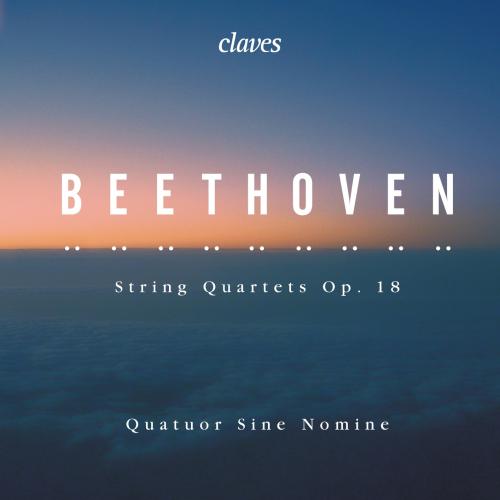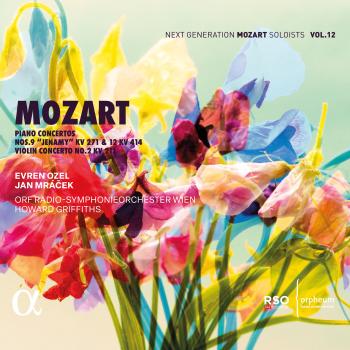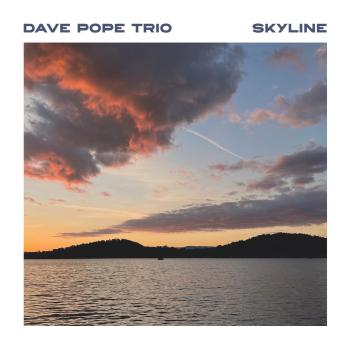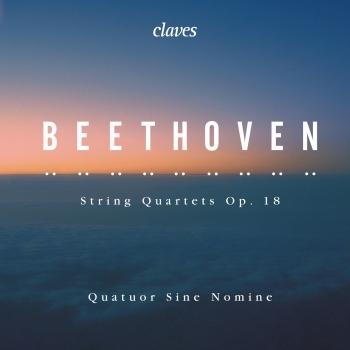
Beethoven: String Quartets, Op. 18 Quatuor Sine Nomine
Album info
Album-Release:
2019
HRA-Release:
06.09.2019
Label: Claves Records
Genre: Classical
Subgenre: Chamber Music
Artist: Quatuor Sine Nomine
Composer: Ludwig van Beethoven (1770–1827)
Album including Album cover
- Ludwig van Beethoven (1770 - 1827): String Quartet No. 1 in F Major, Op. 18:
- 1 String Quartet No. 1 in F Major, Op. 18 : I. Allegro con brio 09:39
- 2 String Quartet No. 1 in F Major, Op. 18 : II. Adagio affettuoso ed appassionato 08:59
- 3 String Quartet No. 1 in F Major, Op. 18 : III. Scherzo 03:12
- 4 String Quartet No. 1 in F Major, Op. 18 : IV. Allegro 06:16
- String Quartet No. 2 in G Major, Op. 18:
- 5 String Quartet No. 2 in G Major, Op. 18 : I. Allegro 07:43
- 6 String Quartet No. 2 in G Major, Op. 18 : II. Adagio cantabile 05:42
- 7 String Quartet No. 2 in G Major, Op. 18 : III. Scherzo 04:15
- 8 String Quartet No. 2 in G Major, Op. 18 : IV. Allegro molto, quasi presto 05:25
- String Quartet No. 3 in D Major, Op. 18:
- 9 String Quartet No. 3 in D Major, Op. 18 : I. Allegro 07:52
- 10 String Quartet No. 3 in D Major, Op. 18 : II. Andante con moto 07:37
- 11 String Quartet No. 3 in D Major, Op. 18 : III. Allegro 02:48
- 12 String Quartet No. 3 in D Major, Op. 18 : IV. Presto 06:44
- String Quartet No. 4 in C Minor, Op. 18:
- 13 String Quartet No. 4 in C Minor, Op. 18: I. Allegro ma non tanto 09:00
- 14 String Quartet No. 4 in C Minor, Op. 18: II. Andante scherzoso quasi allegretto 06:45
- 15 String Quartet No. 4 in C Minor, Op. 18: III. Menuetto. Allegro 03:47
- 16 String Quartet No. 4 in C Minor, Op. 18: IV. Allegretto 04:37
- String Quartet No. 5 in A Major, Op. 18:
- 17 String Quartet No. 5 in A Major, Op. 18: I. Allegro 06:26
- 18 String Quartet No. 5 in A Major, Op. 18: II. Menuetto 05:01
- 19 String Quartet No. 5 in A Major, Op. 18: III. Andante cantabile 09:44
- 20 String Quartet No. 5 in A Major, Op. 18: IV. Allegro 06:37
- String Quartet No. 6 in B-Flat Major, Op. 18:
- 21 String Quartet No. 6 in B-Flat Major, Op. 18: I. Allegro con brio 05:56
- 22 String Quartet No. 6 in B-Flat Major, Op. 18: II. Adagio ma non troppo 07:04
- 23 String Quartet No. 6 in B-Flat Major, Op. 18: III. Scherzo. Allegro 03:10
- 24 String Quartet No. 6 in B-Flat Major, Op. 18: IV. La Malinconia. Adagio - Allegretto quasi allegro 07:58
Info for Beethoven: String Quartets, Op. 18
November 1792. With a grant from the Prince-elector of Cologne and an invitation from Joseph Haydn to come and study with him, young Beethoven arrived in Vienna. At that time, there could be no better place for a musician to make a mark. The capital of the Habsburg Empire concentrated within its walls the finest authors of the Classical period, which was in its heyday. Though composition was not totally ignored, those first few years were primarily dedicated to the study and development of his concert career. His virtuosity rapidly secured him pride of place in the salons, where his interpretation of the Preludes and Fugues of Johann Sebastian Bach’s Well-Tempered Clavier was much appreciated.
Haydn’s departure for England in 1794 meant the end of the grant allocated to the “student” by the Prince-elector. Should he go back to Bonn? Beethoven never even considered it. Over two years, he had made enough friends to envisage an “independent” future quite serenely. His talent won over a few of the capital’s most prominent patrons, who were willing to pay for the services of the pianist for private evenings – and were later to be associated with the advent of his masterpieces. Although he was still to continue playing for a while longer – outshining the greatest virtuosos of his time in contests most dear to the Viennese -, he was increasingly focusing his energy on composition.
It was the end of the 18th century, and he was testing all sorts of genres with great brio, appearing to the audience not only as the worthy descendant of Haydn and Mozart, but also as the forerunner of a new expressive form – indeed a new music. “He commandeers our ears, but not our hearts, reason for which he will never be a Mozart for us”, wrote a critic at the end of a concert in 1796. A comment that says it all on the shock that his music could cause, even that which followed (on paper at least) straight from the classical lineage: the six Quartets op.18 (1798-1800) that concern us here are part of this, as does the “Pathétique” Sonata (1798), the Septet op. 20 (1799), or even the 1st Symphony (1800).
We know that Beethoven received a commission for a first String Quartet in 1795 already from one of the greatest Viennese patrons of the time, Count Anton Georg Apponyi, for whom Haydn had composed his opus 71 et 74 and who had just subscribed to purchasing six copies of his Trios op. 1. For unknown reasons, the process did not go through. Was Beethoven not yet confident enough to rival with the masterpieces of his mentor Haydn and those of Mozart who had just died? However, it was only delayed to later. Three years hence, another illustrious patron came knocking at his door: Prince Franz Joseph Maximilian von Lobkowitz, who made a double commission, both to the pupil and master. Far from recoiling, Beethoven threw himself passionately into the adventure. He was 28 years old and took the order as a challenge, as the opportunity to emancipate himself from his “tutor” in full daylight. The challenge was met: even before being published in 1801 by Tranquillo Mollo (under the French title « Six Quatuors pour deux violons, alto et violoncelle composés et dédiés à son Altesse Monseigneur le prince régnant de Lobkowitz par Louis van Beethoven » [Six Quartets for two violins, viola and ‘cello composed and dedicated to His Highness Prince von Lobkowitz by Ludwig van Beethoven]), the gems of this opus 18 met with great success, whereas Haydn “stalled” and could finally only deliver two quartets (opus 77) in 1802.
As is often the case, the order of publication does not correspond to the order of composition; it was in fact chosen by Beethoven himself, as underlying stylistic “manifests”. As mentioned by Elisabeth Brisson in her excellent Guide de la musique de Beethoven (Fayard, 2005), “Beethoven put the second Quartet (in the order of composition) in first place so as to show off immediately his principles of composition, favouring the initial motif and the work on this motif: this choice implicitly meant that he assumed responsibility for the novelty of his writing and that he was about to offer as many new solutions as quartets to the problems of the composition of such works. Similarly, he put in final place a Quartet that was introducing a new principle of tension.”
To summarise, the opus 18 Quartets were written in the following order: n° 3, 1, 2 (first group completed between the end of autumn 1798 and May 1799, resulting in an initial down payment of 200 Gulden to Beethoven), n° 5 (July-August 1799), 4 (summer-autumn 1799), 6 (between April and summer 1800). The collection was submitted to Prince Lobkowitz in October 1800 and resulted in a second payment of 200 Gulden. As for the first performances, we only have a trace of that of the Third Quartet (in D Major), played privately in the Prince’s salons by an ensemble led by violinist Karl Amenda, a dear friend of Beethoven’s.
Like the Second and Third, the First Quartet (in F Major) was seriously reworked before its submission to the Prince. Beethoven mentioned this in a letter addressed to Amenda on 1st July 1801: “Take care not to share my quartet with anyone, as I have reworked it a lot, considering I only now know how to write quartets correctly, as you will notice when you get them.” We also know, thanks to Amenda, that Beethoven was inspired by the tomb scene of Shakespeare’s Romeo and Juliet for the contours of the slow movement, scene that tells of the heartbreaking separation of the two lovers: a statement confirmed by these verses found (in French) by the Coda on a draft sheet: “Il prend le tombeau / désespoir / il se tue / les derniers soupirs.” (He takes the tomb / despair / he kills himself / the final gasps).
The Second Quartet (in G Major) was nicknamed Komplimentierquartett (literally “Curtsey Quartet”) with reference to its gallant style evoking the aristocracy balls. The Fourth Quartet perfectly summarises the state of mind that Beethoven found himself in when delivering his first quartets to the public: both dependent on the past (certain passages still dated from Bonn) and conscious of the new voice that inhabited him, embodied by a key signature in C Minor, which was to become emblematic of the future dramatic masterpieces to be, such as the “Pathétique” Sonata. Whereas the Second evoked Haydn, the Fifth Quartet (in A Major) is an explicit homage to his other great model, Mozart, and more particularly to his Quartet n° 18 in A Major K. 464. We know from his pupil Czerny that Beethoven copied large passages of the score and apparently exclaimed, while doing so: “This is what I call a work !” Lastly, the Sixth Quartet (in B flat Major) is singled out by a Finale opening onto a poignant Adagio named “La Malinconia” (melancholy) … difficult to be more explicit !
Quatuor Sine Nomine
Quatuor Sine Nomine
After its earliest successes in 1985 at the Evian Competition and in 1987 at the Borciani Competition in Reggio Emilia, Quatuor Sine Nomine of Lausanne, Switzerland has been pursuing an international career and appears in concert in many European and American cities, most notably in London (Wigmore Hall), Amsterdam (Concertgebouw) and New York (Carnegie Hall).
Widely respected artists have had an influence on the development of the quartet: after Rose Dumur Hemmerling, who passed her passion for music on to the ensemble, opening the door to the great string quartet tradition, the Melos Quartet must also be mentioned. The quartet’s work with Henri Dutilleux during recording of his composition “Ainsi la Nuit” was also a milestone in the quartet’s history. Ongoing collaboration with other musicians constantly enriches the ensemble’s perspective. Close relationships with other string quartets have ensued over the years, including with the Berlin-based Vogler Quartet and the Carmina Quartet of Zurich.
The Sine Nomine Quartet has a vast repertoire ranging from Haydn all the way to 21st century works, including rarely performed music such as the Op. 7 Enescu Octet. The quartet has given many premiere performances of new work some of which were dedicated to the ensemble. The quartet’s discography is comprehensive: Alongside the most important works within traditional string quartet repertoire (including complete recordings of the quartets by Schubert and Brahms), Arriaga quartets and the works of Turina have also been recorded, as well as piano quintets by Furtwängler and Goldmark.
In 2001, the quartet initiated the Festival Sine Nomine in Lausanne, which is now successfully held every two years.
The Sine Nomine Quartet receives funding from the city of Lausanne and the canton of Vaud. Its performing career, especially internationally, is also supported by the Association des Amis du Quatuor Sine Nomine, which was founded in 1994. Sine Nomine, meaning “without a name,” is intended to symbolize the constant endeavor of devoting ones efforts to composers and the performance of their works.
This album contains no booklet.










